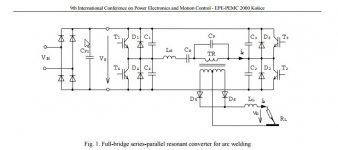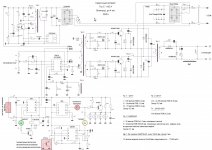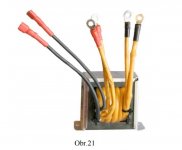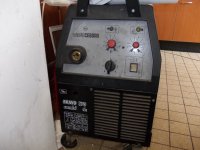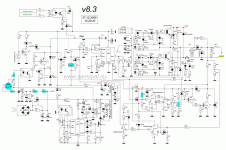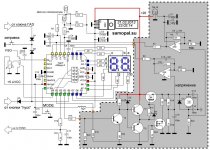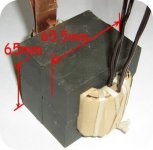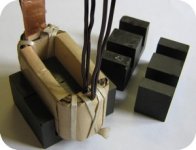Making a combination MIG/TIG machine is going to be quite the undertaking. I've used a couple MIG/TIG combination machines made by major welder companies, and I have yet to use one that could do both processes great. The Thermal-Arc machine I used did both decently, but the performance wasn't anything to write home about and the machine could only weld ferrous metals in either mode. It didn't have AC-TIG capability and in MIG mode, it didn't output enough voltage/current to weld aluminum.
If you're talking about welding aluminum with a MIG machine, a chopper isn't needed. Welding aluminum with the MIG process is done using spray transfer, with DC voltage and the MIG gun is the positive polarity. You simply can't MIG weld properly(on any type of metal) with an AC power source. Some of the cheaper flux-core wire-feed welders use AC power, but they don't weld worth crap.
If you have a properly regulated Constant-Voltage power supply, there is no need for the wire-feed motor to be in the feedback loop of the power supply. The feed motor only needs a control to keep the wire feeding at a consistent rate. For the MIG process to work properly, the power source must output a constant-voltage, the current output is actually automatically determined by how fast the wire-feed rate is(a faster feed basically reduces the _average_ resistance of the arc therefore drawing more current at whatever the set voltage is).
With TIG welding on the other hand. The power supply needs to output a constant-current, regardless of the weld voltage. The weld voltage actually fluctuates with the length of the arc that is between the tip of the tungsten and the surface of the weld pool. This is also true with stick welding since they both use the same type of power source. Stick welding does usually require a power supply capable of outputting a higher weld voltage than the TIG process requires. As a rule of thumb, you can ALWAYS TIG weld(steel) with a DC stick machine, but you can't always stick weld with a DC TIG machine. It just takes a higher voltage to get the arc started with the stick process. With the TIG process, the shielding gas is typically pure argon supplied from a flow-regulated pressurized tank. The gas flow is initiated usually around 100mS to 500mS before the weld current is activated. With the stick process, the shielding gas is provided by the vaporizing and melting of the flux coating on the outside of the welding rod. Therefore, until that flux begins to vaporize and melt, there is no shielding gas around the arc and so a higher voltage is required to maintain the arc in open air until the shielding gas envelops the arc(this does happen very fast). Even then the arc voltage doesn't drop very much. With 7018 type rods, arc voltage can vary from 18-30VDC depending on the weld current itself and the arc length. With rods like the 6010, the flux is cellulose based, and an even higher voltage is required to properly weld with these rods. Many Constant-Current Inverter machines have problems with these types of rods, some to the point where you can't use these rods at all with these machines. Most inverter machines that are capable of burning these rods usually have a special setting that is specifically used for these rods that boosts the open-circuit voltage and the weld voltage itself. Not sure how they're doing it, but I've seen machines with these settings before. Just as an example, I used to have a MASSIVE transformer based TIG/Stick machine circa 1984, the Open-Circuit Voltage was around 80-Volts and at full power it could pull . A typical inverter that is _specifically_ designed for TIG welding, with a well-coupled transformer, only has an OCV of around 30 to 35-Volts and I've seen some as low as 25-Volts. The small MIG machine I mentioned in my last post, that I rewired to be used as a small TIG machine, only has an OCV of about 24-Volts, so while it can TIG weld perfectly fine(on thin metal due to the limited current output), it won't stick weld at all, even with the current maxed out on the smallest diameter rods I could find.
Finally, the only MIG welders that I have seen that have had the feed motor as part of the feedback loop were actually conversion boxes designed to be attached to Constant-Current engine drive welders, out in the field, so that the MIG process could be performed with a CC power supply. These usually were stand-alone boxes. You hooked the output leads of your CC power supply to the box and it worked. I've seen others that also required 120VAC to power the auxiliary circuitry. These typically worked by setting the desired current on your power source, then the MIG box would automatically and constantly, adjust the wire-feed rate to maintain a consistent arc-length to keep the voltage as steady as possible. Other boxes have their own control for the feed-rate but this usually only sets the "average" feed rate, the actual rate is still adjusted by the controller while you are welding to compensate for using the wrong type of power source for the process. While these type of MIG conversion boxes usually worked great out in the field for the high-power welding of thick materials, from what I've read, they are completely useless on anything that requires finesse. I would assume that is because when doing heavy-duty MIG welding, it is usually done using the "globular-transfer" or "spray-transfer" methods at higher weld voltages, whereas thinner materials are welded using the "short-circuit-transfer" method at lower voltages. Your typical hobby-grade MIG welder uses the latter of those three.
Also, with your output current being limited to 160-Amps. You won't be able to weld much aluminum with it. 1/8-inch will be about the max you can weld properly using the AC-TIG process, and even at that, getting the initial weld pool started will take longer than is usually deemed appropriate and could cause problems in the surrounding metal around the weld area. Aluminum is a very good heat-sink. When you first strike your arc on aluminum with a TIG machine, it is common practice to floor the foot pedal to where the machine is outputting about double the required amperage. This causes the weld pool to form VERY fast under the arc while reducing the amount of time the heat has to spread into the rest of the material. Once the weld pool is created, you can back off the amperage and begin moving the weld bead along the joint. You need to move fast and steady and try to stay in front of the heat that is spreading into the surrounding material. If you don't have enough amperage, your travel speed will have to be much slower causing the heat to build up in the part, this can be very problematic on important joints, and catastrophic on certain aluminum alloys.
MIG welding aluminum at that low of a current will be almost impossible. The MIG process for aluminum is usually reserved for welding thick structural joints(1/4-inch and thicker). MIG welding thinner aluminum is very difficult with any type of machine mainly because MIGing aluminum uses the "spray-transfer" method, at higher weld voltages, and it produces a very large amount of heat into the material that you are trying to weld. I've seen robots MIG weld on thin aluminum(1/8") but there was still burn through problems.
PS - I'll have a look at that schematic you attached as soon as a get a chance.

